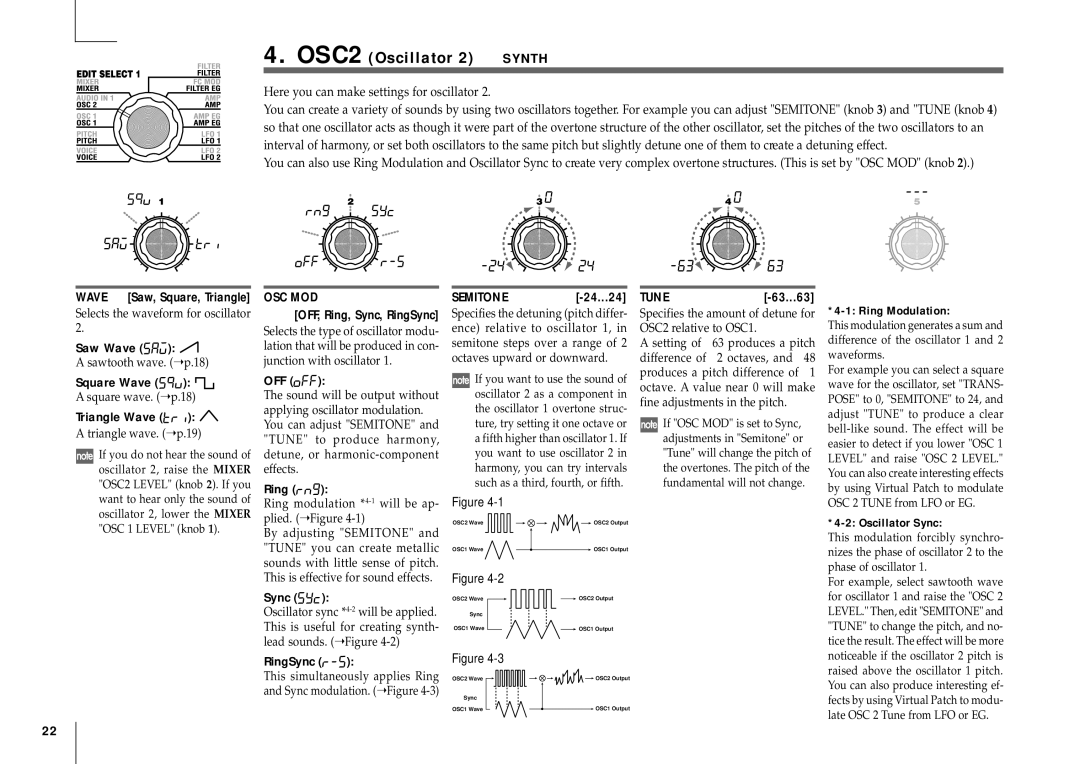
4.OSC2 (Oscillator 2) — SYNTH
Here you can make settings for oscillator 2.
You can create a variety of sounds by using two oscillators together. For example you can adjust "SEMITONE" (knob 3) and "TUNE (knob 4) so that one oscillator acts as though it were part of the overtone structure of the other oscillator, set the pitches of the two oscillators to an interval of harmony, or set both oscillators to the same pitch but slightly detune one of them to create a detuning effect.
You can also use Ring Modulation and Oscillator Sync to create very complex overtone structures. (This is set by "OSC MOD" (knob 2).)
WAVE [Saw, Square, Triangle]
Selects the waveform for oscillator 2.
Saw Wave (![]()
![]()
![]() ):
): ![]()
A sawtooth wave. (➝ p.18)
Square Wave (![]()
![]()
![]() ):
): ![]()
A square wave. (➝ p.18)
Triangle Wave (![]()
![]()
![]() ):
): ![]()
A triangle wave. (➝ p.19)
![]() If you do not hear the sound of oscillator 2, raise the MIXER "OSC2 LEVEL" (knob 2). If you want to hear only the sound of oscillator 2, lower the MIXER "OSC 1 LEVEL" (knob 1).
If you do not hear the sound of oscillator 2, raise the MIXER "OSC2 LEVEL" (knob 2). If you want to hear only the sound of oscillator 2, lower the MIXER "OSC 1 LEVEL" (knob 1).
OSC MOD
[OFF, Ring, Sync, RingSync]
Selects the type of oscillator modu- lation that will be produced in con- junction with oscillator 1.
OFF (![]()
![]()
![]() ):
):
The sound will be output without applying oscillator modulation. You can adjust "SEMITONE" and "TUNE" to produce harmony, detune, or
Ring (![]()
![]()
![]() ):
):
Ring modulation *4-1 will be ap- plied. (➝ Figure 4-1)
By adjusting "SEMITONE" and "TUNE" you can create metallic sounds with little sense of pitch. This is effective for sound effects.
Sync (

 ):
):
Oscillator sync
SEMITONE[-24...24]
Specifies the detuning (pitch differ- ence) relative to oscillator 1, in semitone steps over a range of 2 octaves upward or downward.
![]() If you want to use the sound of oscillator 2 as a component in the oscillator 1 overtone struc- ture, try setting it one octave or a fifth higher than oscillator 1. If you want to use oscillator 2 in harmony, you can try intervals such as a third, fourth, or fifth.
If you want to use the sound of oscillator 2 as a component in the oscillator 1 overtone struc- ture, try setting it one octave or a fifth higher than oscillator 1. If you want to use oscillator 2 in harmony, you can try intervals such as a third, fourth, or fifth.
Figure
OSC2 Wave | OSC2 Output |
OSC1 Wave | OSC1 Output |
Figure |
|
OSC2 Wave | OSC2 Output |
Sync |
|
OSC1 Wave | OSC1 Output |
TUNE[-63...63]
Specifies the amount of detune for OSC2 relative to OSC1.
A setting of ± 63 produces a pitch difference of ± 2 octaves, and ± 48 produces a pitch difference of ± 1 octave. A value near 0 will make fine adjustments in the pitch.
![]() If "OSC MOD" is set to Sync, adjustments in "Semitone" or "Tune" will change the pitch of the overtones. The pitch of the fundamental will not change.
If "OSC MOD" is set to Sync, adjustments in "Semitone" or "Tune" will change the pitch of the overtones. The pitch of the fundamental will not change.
*4-1: Ring Modulation:
This modulation generates a sum and difference of the oscillator 1 and 2 waveforms.
For example you can select a square wave for the oscillator, set "TRANS- POSE" to 0, "SEMITONE" to 24, and adjust "TUNE" to produce a clear
*4-2: Oscillator Sync:
This modulation forcibly synchro- nizes the phase of oscillator 2 to the phase of oscillator 1.
For example, select sawtooth wave for oscillator 1 and raise the "OSC 2 LEVEL." Then, edit "SEMITONE" and "TUNE" to change the pitch, and no- tice the result. The effect will be more
RingSync (

 ):
):
This simultaneously applies Ring and Sync modulation. (➝Figure
Figure
OSC2 Wave | OSC2 Output |
Sync |
|
OSC1 Wave | OSC1 Output |
noticeable if the oscillator 2 pitch is raised above the oscillator 1 pitch. You can also produce interesting ef- fects by using Virtual Patch to modu- late OSC 2 Tune from LFO or EG.
22
